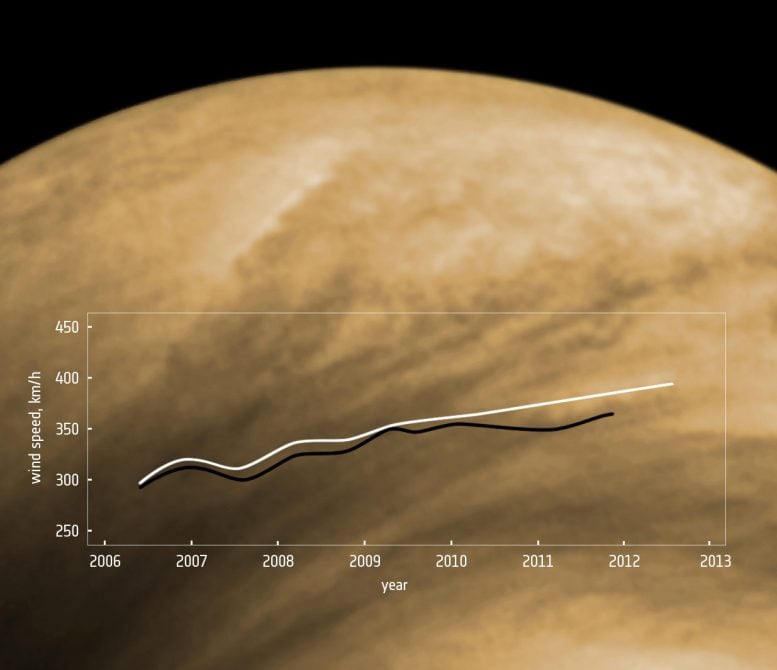
Examples of cloud features identified in Venus Express images and used to monitor wind speeds. Long-term studies based on tracking the motions of several hundred thousand cloud features, indicated here with arrows and ovals, reveal that the average wind speeds on Venus have increased from roughly 300 km/h to 400 km/h over the first six years of the mission. Daily and yearly variations, as well as unexplained differences between consecutive orbits of the spacecraft, were also identified. These images were taken on 27 October 2008. The arrows and ovals are colored to improve contrast against their respective backgrounds. Credit: Khatuntsev et al, Cloud level winds from the Venus Express Monitoring Camera imaging, Icarus (2013); doi: 10.1016/j.icarus.2013.05.018
Using the Venus Monitoring Camera, scientists tracked the movements of distinct cloud features in the atmosphere of Venus over a period of 10 Venusian years, discovering that the planet’s winds have steadily been getting faster.
The most detailed record of cloud motion in the atmosphere of Venus chronicled by ESA’s Venus Express has revealed that the planet’s winds have steadily been getting faster over the last six years.
Venus is well known for its curious super-rotating atmosphere, which whips around the planet once every four Earth days. This is in stark contrast to the rotation of the planet itself – the length of the day – which takes a comparatively laborious 243 Earth days.
By tracking the movements of distinct cloud features in the cloud tops some 70 km (43 mi) above the planet’s surface over a period of 10 Venusian years (6 Earth years), scientists have been able to monitor patterns in the long-term global wind speeds.
When Venus Express arrived at the planet in 2006, average cloud-top wind speeds between latitudes 50º on either side of the equator were clocked at roughly 300 km/h (190 mi/h). The results of two separate studies have revealed that these already remarkably rapid winds are becoming even faster, increasing to 400 km/h (250 mi/h) over the course of the mission.
“This is an enormous increase in the already high wind speeds known in the atmosphere. Such a large variation has never before been observed on Venus, and we do not yet understand why this occurred,” says Igor Khatuntsev from the Space Research Institute in Moscow and lead author of the Russian-led paper to be published in the journal Icarus.

Long-term studies of the atmosphere of Venus by ESA’s Venus Express find that the average wind speeds at low latitudes (between the equator and 50º north or south) have increased from roughly 300 km/h to 400 km/h over the first six years of the mission. In this graph, the white line shows the data derived from manual cloud tracking, and the black line is from digital tracking methods. Credit: Data: Khatuntsev et al; background image: ESA
Dr Khatuntsev’s team determined the wind speeds by measuring how cloud features in images moved between frames: over 45,000 features were painstakingly tracked by hand and more than 350,000 further features were tracked automatically using a computer program.
In a complementary study, a Japanese-led team used their own automated cloud tracking method to derive the cloud motions: their results are to be published in the Journal of Geophysical Research.
On top of this long-term increase in the average wind speed, however, both studies have also revealed regular variations linked to the local time of day and the altitude of the Sun above the horizon, and to the rotation period of Venus.
One regular oscillation occurs roughly every 4.8 days near the equator and is thought to be connected to atmospheric waves at lower altitudes.
But the research also unveiled some harder-to-explain curiosities.
“Our analysis of cloud motions at low latitudes in the southern hemisphere showed that over the six years of study the velocity of the winds changed by up 70 km/h over a time scale of 255 Earth days – slightly longer than a year on Venus,” says Toru Kouyama from the Information Technology Research Institute in Ibaraki, Japan.
The two teams also saw dramatic variations in the average wind speeds between consecutive orbits of Venus Express around the planet.
In some cases, wind speeds at low latitudes varied such that clouds completed one journey around the planet in 3.9 days, while on other occasions they took 5.3 days.
Scientists currently have no explanation for either of these variations, or for the long-term overall increase in wind speeds.
“Although there is clear evidence that the average global wind speeds have increased, further investigations are needed in order to explain what drives the atmospheric circulation patterns that are responsible, and to explain the changes seen in localized areas on shorter timescales,” says Håkan Svedhem, ESA’s Venus Express Project Scientist.
“The atmospheric super-rotation of Venus is one of the great unexplained mysteries of the Solar System. These results add more mystery to it, as Venus Express continues to surprise us with its ongoing observations of this dynamic, changing planet.”
The observations were carried out using the Venus Monitoring Camera (VMC; principal investigator W. Markiewicz, MPI-Ae, Katlenburg-Lindau, Germany). The VMC is a wide-angle multichannel camera that takes images in the near-infrared, ultraviolet, and visible wavelengths.
References:
“Cloud level winds from the Venus Express Monitoring Camera imaging” by I.V. Khatuntsev, M.V. Patsaeva, D.V. Titov, N.I. Ignatiev, A.V. Turin, S.S. Limaye, W.J. Markiewicz, M. Almeida, Th. Roatsch and R. Moissl, 1 June 2013, Icarus.
DOI: 10.1016/j.icarus.2013.05.018
“Long-term variation in the cloud-tracked zonal velocities at the cloud top of Venus deduced from Venus Express VMC images” by Toru Kouyama, Takeshi Imamura, Masato Nakamura, Takehiko Satoh and Yoshifumi Futaana, 30 January 2013, Journal of Geophysical Research: Planets.
DOI: 10.1029/2011JE004013









Maybe Venus is going through global warming to. More so than usual if that is possible, and that is making clouds move faster? or Maybe the current season of the sun is affecting cloud speed? since a suns season can affect weather on earth I imagine it would do the same on Venus.
Dude, read up on Venus before you comment. The atmosphere is virtually all co2, global warming has been rampant there for a super long time. It’s very hot on Venus. Also, I am pretty sure scientists would compare wind speeds at relative times so they have accounted for times of year etc. Who knows, maybe they are going to come up with some crazy discovery like the magnetic field is weakening, that it looks like it is cycling through a flip and it’s not blocking outside elements as well and that is why the wind speeds are gradually increasing.
Perhaps I didnt explain clearly Gpc. I was refering to increased warming above and beyond the normal global warming that we see today and perhaps the ending of or beginning of an even larger trend like how earth goes through ice ages every millions of years maybe Venus goes though something similar but it higher temperature ranges. It would be the kind of thing that scientists dont have wind data to compare to becuase of the time period we would be dealing with.
shut your mouth jim